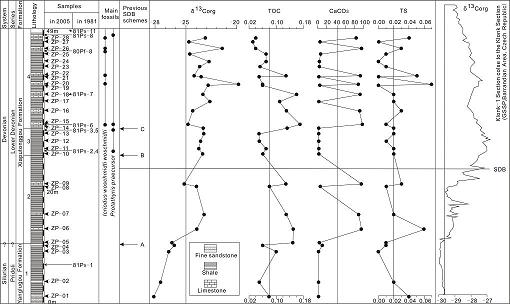Carbon Isotope Shifts Defining the Silurian-Devonian Boundary in West Qinling of China

Fig.1: Stratigraphic succession, carbonate and total organic carbon as well as stable isotopic ratio of organic carbon versus depth in the Yanglugou Section, West Qinling of China. (Courtesy of Dr. Wen-jin Zhao)
The Silurian-Devonian Boundary selected as a Global Stratotype Section and Point (GSSP) by the International Union of Geological Sciences in Montreal in 1972 is defined at the base of the graptolite Monograptus uniformis uniformis in the upper part of Bed No. 20 at at Klonk near Suchomasty, Prague, Czech Republic. The auxiliary indicators of the boundary include the first occurrence of the trilobite Warburgella rugulosa rugosa and the conodont Icriodus woschmidti woschmidti. However, except I. woschmidti woschmidti, other indicator fossils cannot be found in West Qinling because they are restricted to the typical pelagic facies in general. The SDB in West Qinling remains contentious.
Based on previous studies on biostratigraphy, Dr. Wen-jin Zhao, Key Laboratory of Evolutionary Systematics of Vertebrates, Institute of Vertebrate Paleontology and Paleoanthropology (IVPP), Chinese Academy of Sciences, and his collaborators collected 45 samples at about 1.5 m intervals from a 35 m section (Yanglugou Section - ZY Section) and a 48 m section (Putonggou Section - ZP Section) in West Qinling. Wen-jin Zhao and his collaborators then analysed the contents of organic carbon, carbonate carbon and total sulphur, in order to check the availability of organic carbon for isotopic analyses and to provide additional data for a better definition of the SDB in the Putonggou and Yanlugou sections of West Qinling.
The two sections, Putonggou and Yanglugou sections in West Qinling, reveal positive δ13Corg shifts happening in the upper Pridoli and lower Devonian and reaching peak values as heavy as -19.9‰ (Putonggou) and -19.7‰ (Yanglugou) in the lowermost Lochkovian following the first occurrence of the Protathyris-Lanceomyonia brachiopod fauna and the conodont Icriodus woschmidti woschmidti. The δ13Corg variations across the Silurian-Devonian transition at the two sections in West Qinling exhibit a similar shift in their carbon isotopic composition as the detailed SDB curves from the borehole Klonk-1 drilled at top of the Klonk GSSP in the Prague Basin, Czech Republic. These results as published in Bollettino della Società Paleontologica Italiana 49 (1), 2010, suggesting that the SDB in West Qinling is located at the upper part of the Yanglugou Formation (between ZY-07 and ZY-06) in the Yanglugou Section and the lower part of the Xiaputonggou Formation (between ZP-09 and ZP-10) in the Putonggou Section.
“The isotopic trend for organic carbon across the Silurian-Devonian Boundary (SDB) offers an approach to a potential correlation of the SDB from different sedimentary facies,” said Dr. Wen-jin Zhao, “Although more data will help to reveal individual causes for the isotopic shift, such as enhanced carbon burial due to anoxic conditions and/or increased productivity, alternating arid and humid periods, or changes in the composition of primary producers, our analysis does help narrow the depth interval for future detailed studies in paleontology and chemostratigraphy and for a precise position of the SDB in this region.”
Download attachments: